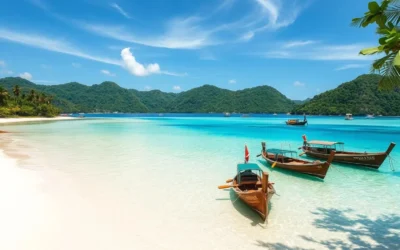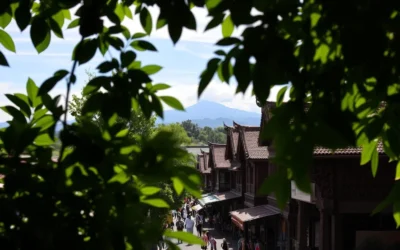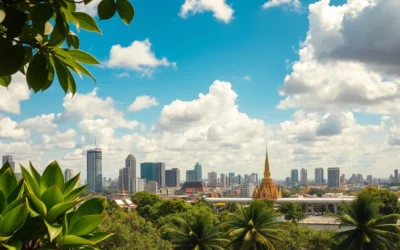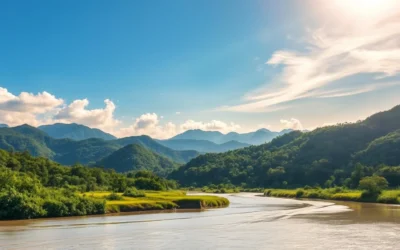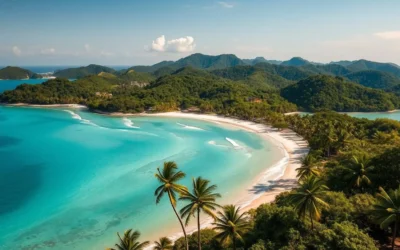✓ Accommodations✓ Flights✓ Rental Cars
You’re about to uncover a treasure trove of cultural heritage and natural beauty in a city that’s often overlooked by travelers. With its rich history, vibrant culture, and stunning landscapes, this destination is a must-visit for any traveler.
Imagine a place where Chinese, Malay, and Thai influences blend seamlessly, creating a unique cultural landscape that’s reflected in its architecture, cuisine, and local traditions. This charming coastal city offers a perfect blend of cultural immersion, natural beauty, and authentic experiences without the crowds.
As you explore this hidden gem, you’ll discover historic landmarks, pristine beaches, and local culinary delights that will make your journey unforgettable.
Discovering Songkhla: Thailand’s Hidden Southern Gem
Songkhla, a provincial capital in Southern Thailand, is a unique blend of cultures and landscapes. Located in the Mueang Songkhla District, it is a city that straddles a narrow peninsula between the South China Sea and a saltwater estuary known locally as ‘The Lake’.
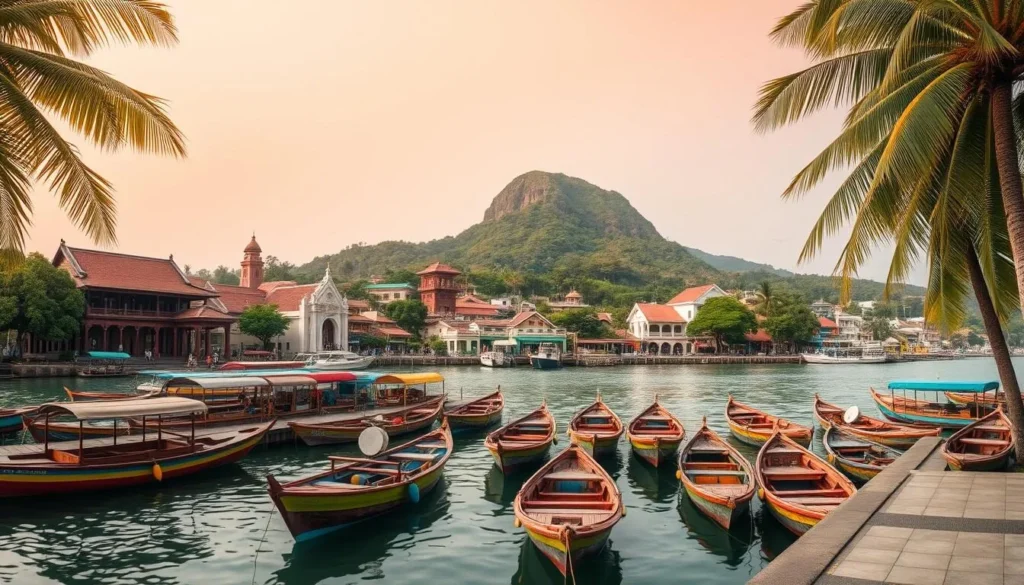
While Hat Yai is often the more recognized city in the region, being the commercial hub of southern Thailand, Songkhla offers a more authentic and less commercialized Thai experience. The area boasts a fascinating multicultural heritage with strong influences from Chinese, Malay, and Thai cultures.
One of the key advantages of visiting Songkhla is its relative obscurity to international tourists, allowing for a more genuine cultural immersion. Unlike the tourist-heavy destinations of Phuket or Krabi, Songkhla remains a hidden gem. Hat Yai serves as the main gateway to Songkhla for many travelers, with frequent transportation options connecting these two important cities.
- Songkhla is strategically positioned on a narrow peninsula, creating a unique geographical setting.
- The city offers a blend of beautiful beaches and lush hills, providing varied experiences.
- Hat Yai is a major commercial hub and gateway to Songkhla.
- The multicultural heritage of Songkhla is distinctly different from other tourist destinations.
In summary, Songkhla is a treasure trove of cultural and natural beauty, waiting to be explored. With its unique geography, rich heritage, and authentic Thai experience, it’s a destination that should be on every traveler’s list, especially those visiting Hat Yai.
The Rich History of Songkhla
With roots dating back to the 12th century, Songkhla’s history is as complex as it is captivating. The city’s original name was Singgora, meaning ‘the city of lions,’ a name given by Persian and Indian traders who likened the islands of Koh Nu and Koh Maeo to crouching lions guarding the estuary.
As you explore the city‘s past, you’ll find that Songkhla has been a melting pot of cultures. It served as the center of power for the northern territories of the Malay Kingdom of Langkasuka from the 3rd to the 13th century. The strategic location of the region made it a contested area, transitioning from the Sultanate of Singgora before officially becoming part of Thailand with the Anglo-Siamese Treaty of 1909.
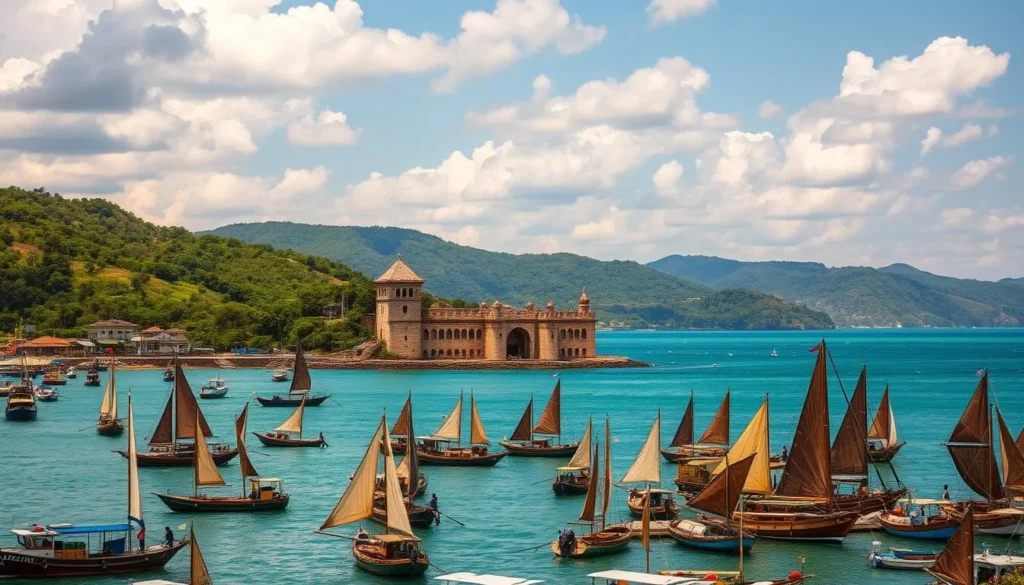
The history of Songkhla is preserved in its architecture, particularly in the Old Town area, where many buildings and temples date back to the 1800s. This makes the city a living museum of the region‘s complex past. Over time, Chinese immigration in the 19th century significantly shaped Songkhla’s cultural landscape, with King Rama IV recognizing the economic benefits and allowing freedom of Chinese religion and ceremonies that are still celebrated in the city today.
Here’s a brief overview of Songkhla’s historical milestones:
| Period | Event | Significance |
|---|---|---|
| 12th Century | Establishment as a port town | Began Songkhla’s legacy as a significant trading hub |
| 3rd-13th Century | Center of power for Malay Kingdom of Langkasuka | Cultural melting pot and strategic importance |
| 19th Century | Chinese immigration | Shaped cultural landscape and economic growth |
| 1909 | Anglo-Siamese Treaty | Officially became part of Thailand |
Today, Songkhla is home to a rich cultural heritage, making it a fascinating destination for those interested in history and cultural diversity. As you walk through the Old Town, you’ll feel like you’re stepping back in time, surrounded by the legacy of a complex and captivating past.
Songkhla Old Town: A Cultural Journey
Stepping into Songkhla Old Town is like entering a time capsule, where ancient architecture meets contemporary creativity. As you explore this historic district, you’ll uncover the heart and soul of Songkhla’s cultural heritage.
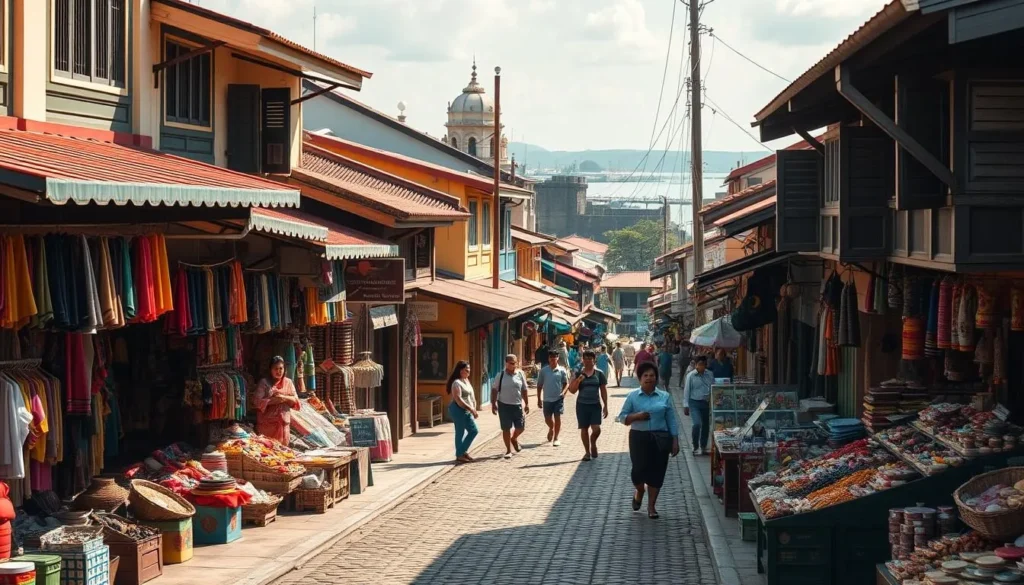
Songkhla Old Town represents the heart and soul of the city’s cultural heritage, with well-preserved Chinese-influenced architecture that tells the story of the area’s prosperous trading past. Walking through the narrow streets feels like stepping back in time, with rows of colorful Sino-Portuguese shophouses that have remained largely unchanged for generations.
Street Art and Creative Spaces
The Old Town has been revitalized with an impressive collection of street art since 2016, rivaling the famous murals of Penang, Malaysia, and adding a contemporary artistic layer to the historic district. The art often depicts scenes from local history, folklore, and daily life, creating an open-air gallery that enhances the cultural experience for visitors.
Beyond the art, Old Town is home to several creative spaces like the Hub Ho Hin building, a former rice mill turned ice factory that now serves as a community art center hosting exhibitions and performances. Maritime enthusiasts will appreciate the Buddaraksa and Saksitphithak Jetties, which have been transformed into mini-community parks complete with benches and street art, offering perfect spots for watching the sunset over the fishing boats. The transformation of these spaces reflects the community’s effort to blend tradition with modern creativity, making Songkhla Old Town a unique cultural destination.
As you stroll through the old town, you’ll notice the seamless blend of traditional and contemporary elements, from the street art adorning the walls to the vibrant cultural activities that take place in the community spaces. This blend is what makes Songkhla Old Town such a compelling place to visit, offering a deep dive into the city’s history and culture.
Samila Beach: Songkhla’s Coastal Treasure
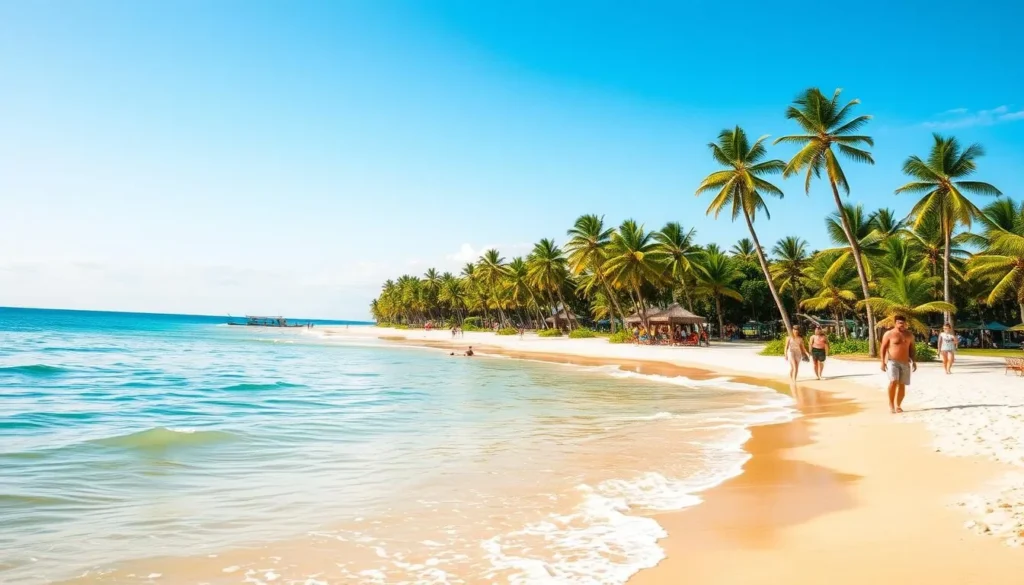
Samila Beach stands out as a preserved paradise on Thailand’s southern coast. You can enjoy a serene escape with its endless golden sand beach and plenty of shady pine trees. This beloved attraction is a magnet for both locals and tourists, especially on weekends and holidays.
The majority of the beach scene is concentrated around the iconic Golden Mermaid Statue, a symbol of Samila Beach and a must-photograph spot for visitors. The statue represents a character from famous Thai folklore, adding a touch of local culture to your beach experience.
The Legendary Mermaid and Naga Sculptures
The area around Samila Beach is not just about the mermaid statue; it’s also home to various artistic installations throughout the seafront areas of Sculpture Garden Chaloem Phrakiat and nearby Seri Park. You can explore these cultural spots, enhancing your overall beach experience.
One of the notable attractions is the majestic Naga sculpture at the northern end of Samila Beach. Considered a sacred site by locals, it features a 9-meter high water-spewing fountain, creating a spectacular sight against the backdrop of Songkhla Lake.
As you visit Samila Beach, you’ll appreciate its local character, with shady pine trees lining the shore and a relaxed atmosphere. The beach extends beyond the main tourist section, offering less crowded spots both north toward Laem Son On (Pine Tree Cape) and south where Samila Beach becomes Chalatat Beach.
Must-Visit Temples and Religious Sites
As you explore Songkhla, you’ll discover a rich tapestry of temples and religious sites that showcase the city’s deep-rooted spiritual heritage. The city is home to numerous significant Buddhist temples and religious sites, with over 15 wats scattered throughout the city.
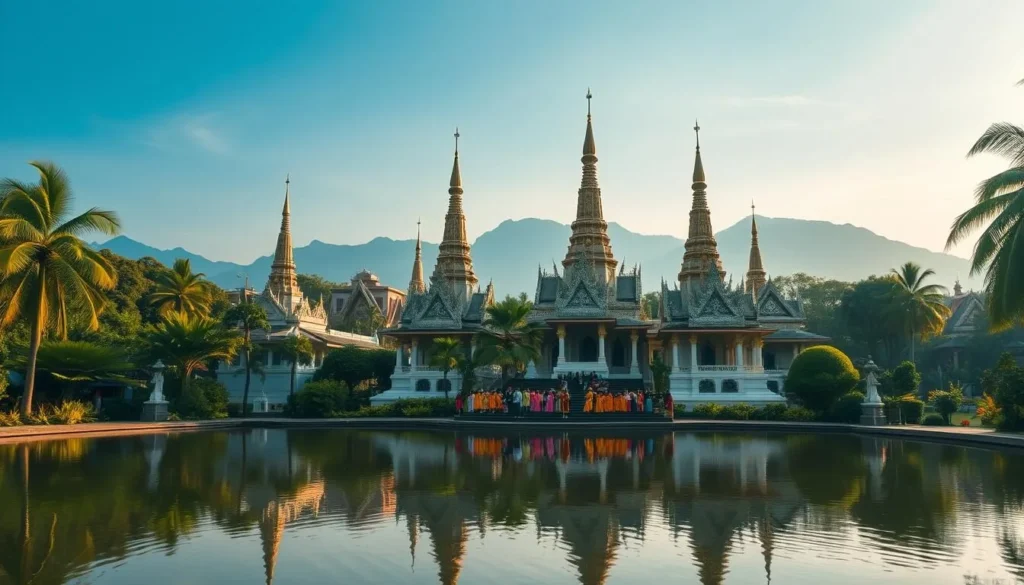
One of the most impressive religious sites is Khao Tang Kuan (Tan Kuan Hill), featuring the historic Sala Phra Wihan Daeng Royal Pavilion and the golden Phra Chedi Luang Royal Pagoda visible for miles around. The pavilion was initially constructed during the reign of King Rama IV in 1886.
Khao Tang Kuan (Tan Kuan Hill)
Khao Tang Kuan stands as a prominent landmark in Songkhla, offering breathtaking panoramic views of the city and coastline. Visitors can choose between taking the elevator for 30 baht or climbing the dramatic 300-step Naga staircase for free.
| Attraction | Description |
|---|---|
| Sala Phra Wihan Daeng Royal Pavilion | A historic pavilion constructed during the reign of King Rama IV |
| Phra Chedi Luang Royal Pagoda | A golden pagoda visible for miles around |
| Naga Staircase | A dramatic 300-step staircase leading to the top of Khao Tang Kuan |
In addition to Khao Tang Kuan, other notable temples in Songkhla include Wat Matchimawat (Wat Klang), considered one of the most important Buddhist temples in the city, with its 400-year-old structures and the unique Matchimawat National Museum. The City Pillar Shrine (Lak Mueng) is another significant site, holding profound importance as the heart of the community.
For a unique religious experience, you can visit Phra Maha Chedi Tripob Trimongkol, the world’s only stainless steel pagoda, built to commemorate King Bhumibol Adulyadej’s 60th year on the throne. These temples and religious sites make Songkhla a fascinating destination for any tourist looking to explore the city’s spiritual heritage.
Hat Yai Municipal Park: Nature and Recreation
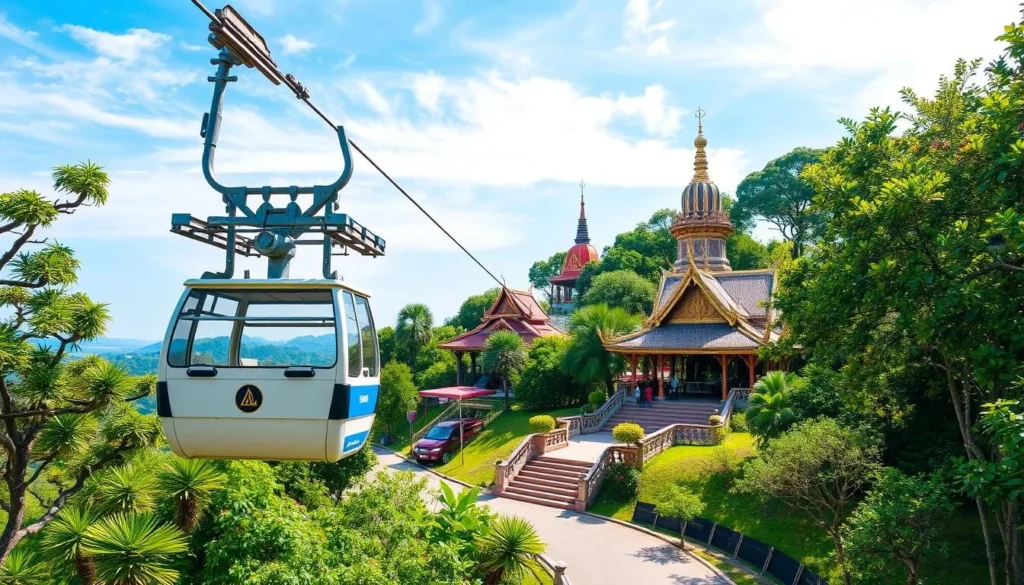
As one of the region’s most beloved green spaces, Hat Yai Municipal Park is a must-visit for nature lovers and those seeking recreation. This park is not just a tourist spot but also a recreational area for locals, offering a wide range of activities suitable for all ages.
The park’s main attraction is its hilltop area, accessible via a scenic cable car ride that provides spectacular views of Hat Yai and surrounding areas. Although the cable car was inoperative during my visit, alternative transportation was available, ensuring that visitors could still enjoy the hilltop attractions.
Unlike some urban parks that feel lifeless, Hat Yai Municipal Park buzzes with activity as locals gather for picnics, dates, and family outings around the central lake surrounded by trees. The hilltop section houses several temples and shrines, including a prominent Buddha shrine and a Guan-yin temple, adding cultural and spiritual dimensions to your visit.
The contrast between the lively atmosphere at the park entrance and the more serene environment up on the hill creates two distinct experiences within the same municipal park. With a small fee of only 15 THB (around $0.5 USD) to access the hill area, Hat Yai Municipal Park offers exceptional value for visitors looking to enjoy both nature and cultural attractions in one location.
Songkhla’s Culinary Delights
As you explore Songkhla, you’ll discover a rich culinary landscape that blends traditional Thai, Chinese, Malay, and Muslim cuisines. The city offers an incredible array of flavors, ensuring that your culinary experience is nothing short of delightful. With plenty of cheap eats available, you can indulge in various dishes without breaking the bank.
One of the highlights of Songkhla’s culinary scene is its street food, which is both abundant and affordable. You can find delicious dishes like satay and other meat on a stick within walking distance of most accommodations in the city center. For a truly authentic local experience, be sure to try Chen Loong Boat Noodle, a legendary culinary institution known for its flavorful noodle soups.
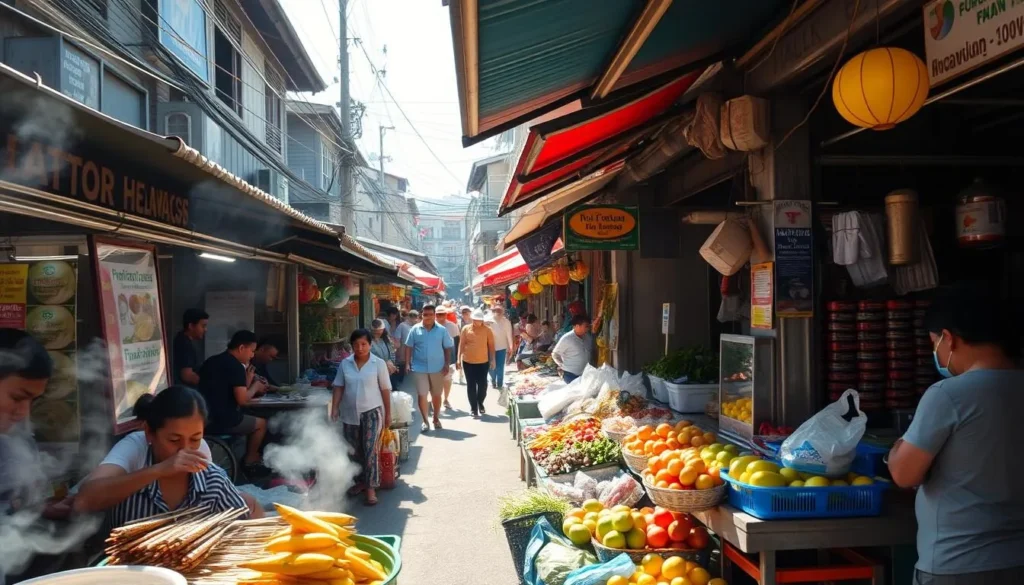
The Weekend Night Market, held on Fridays through Sundays from 17:00 to 21:00, transforms Chana Road into a food lover’s paradise. Vendors serve everything from skewers of satay to piping hot cauldrons of Thai-Muslim Oxtail Soup, offering a diverse range of food options that cater to various tastes. This event is a highlight for both visitors and locals, showcasing the best of Songkhla’s culinary delights.
Markets and Food Bazaars
Songkhla’s markets and food bazaars are a treasure trove of culinary experiences. Places like Kim Yong Market offer not just meals but also ingredients, snacks, and sweets that make perfect souvenirs. You can explore these markets to sample local delicacies and purchase unique gifts to bring home a taste of Songkhla.
The high percentage of Muslim residents in the region means that halal food options are widely available, making Songkhla an excellent destination for Muslim travelers. The city’s culinary scene is a reflection of its cultural diversity, with many food options available to suit different dietary preferences.
- Explore the Weekend Night Market for a variety of street food and local delicacies.
- Visit Chen Loong Boat Noodle for an authentic taste of traditional Thai noodle soups.
- Discover the unique flavors and ingredients available at markets like Kim Yong Market.
Day Trips from Songkhla
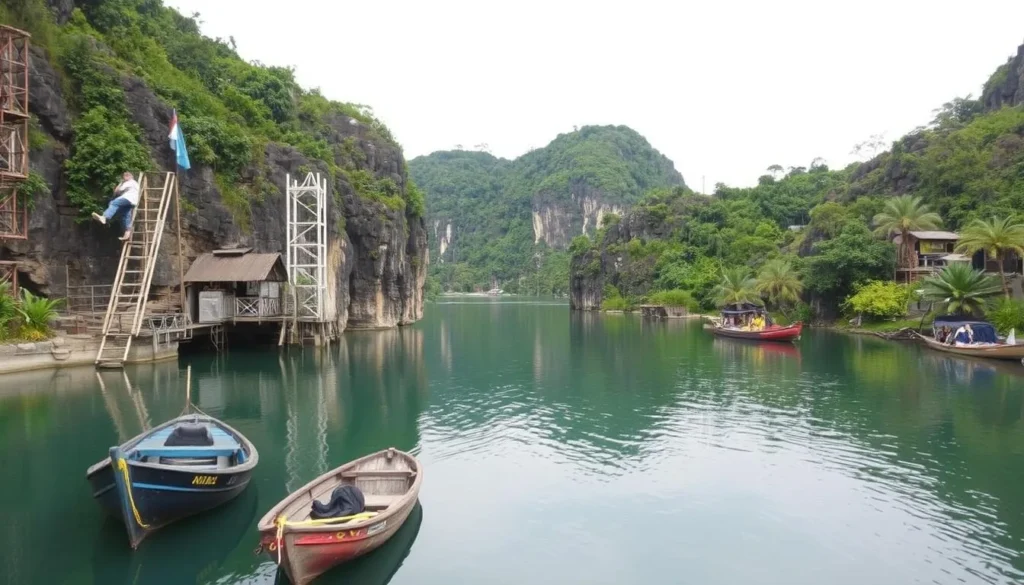
Songkhla serves as an ideal base for various day trips that showcase the region’s diverse attractions. You can easily explore nearby destinations, enjoying a mix of culture, nature, and relaxation.
One perfect day trip is to Ko Yo Island, accessible by car via the Tinsulanonda Bridge or by ferry. While there, visit the famous Sleeping Buddha at Wat Phranon Laem Pho, though some visitors find it less impressive than anticipated.
Hat Yai, just 30-45 minutes away by car, offers additional things to do, including shopping at the ASEAN Night Bazaar and Kim Yong Market. It’s an easy day excursion from Songkhla, making it a great experience for travelers.
Nature enthusiasts should consider a day trip to Ton Nga Chang Waterfall, one of Hat Yai‘s most famous natural attractions, featuring seven-tiered falls within a wildlife sanctuary rich in biodiversity.
For a more off-the-beaten-path experience, rent a motorbike and take the ferry to explore the dusty back roads on the other side of Songkhla Lake. Alternatively, visit Khao Khuha for panoramic views and a potentially magical atmosphere at dawn.
These day trips from Songkhla offer a variety of things to see and do, ensuring that your visit is filled with memorable experiences.
Where to Stay in Songkhla
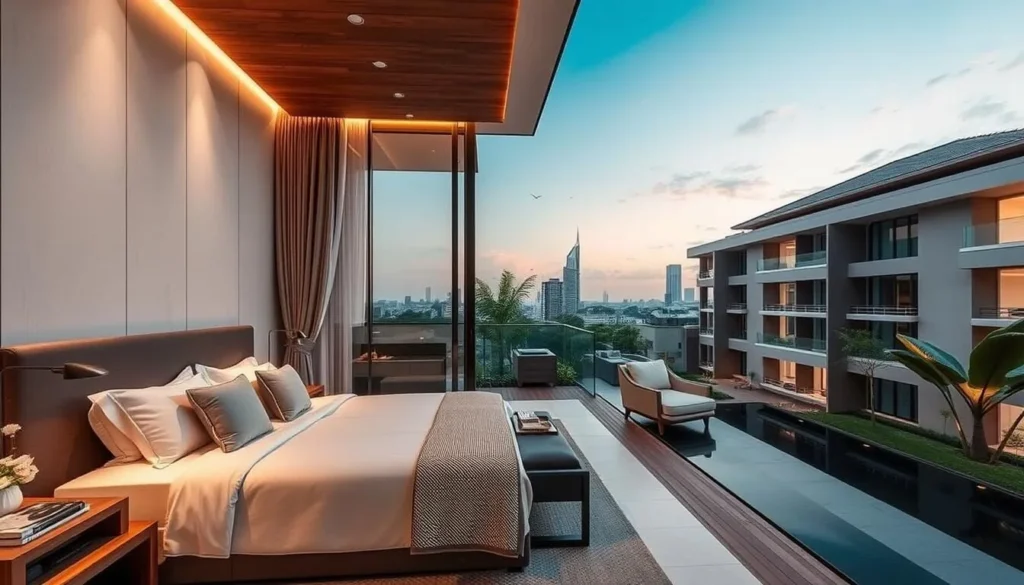
Finding the perfect place to stay in Songkhla is easy, thanks to its plenty of accommodation options. Whether you’re looking for a luxurious retreat or a simple place to rest, Songkhla has something for everyone. The city offers a diverse array of places to stay, from luxury hotels to budget-friendly guesthouses, all providing good value compared to Thailand’s more touristy destinations.
One of the top recommendations is The Luxury Residence, which stands out for its central location, comfortable rooms with kitchenettes, and exceptional customer service. They were extremely helpful in providing local information and arranging transportation, making it a top choice for travelers.
For budget travelers, Holland House is a great option, offering clean and simple rooms directly across from the Songkhla National Museum. Families might prefer the B.P. Samila Beach Hotel, which offers beachfront access and a swimming pool, though the rooms have a somewhat retro feel.
If you prefer to stay in a more commercial center, Hat Yai offers additional accommodation options. It’s essential to distinguish between Songkhla City and the larger Songkhla Province when booking to ensure you’re staying in your intended location.
With plenty of options available, you’re sure to find the perfect place to stay in Songkhla, making your trip even more enjoyable.
Practical Travel Tips for Songkhla
Getting to Songkhla is just the beginning; here’s how you can navigate and enjoy this beautiful city like a local. For mosttravelers,Hat Yaiserves as the main gateway, with a direct route into Songkhla City via the northbound 407 highway, taking about 30-45 minutes.
When arriving from the north, you have two options: take the 408 southbound highway to 4222 and use the small car ferry, or continue on the 408 and cross the bridge to Ko Yo and then to the mainland. If you’re arriving from Bangkok, flying intoHat YaiInternational Airport and then taking ground transportation is the most convenient option.
Interacting withlocalsrequires some cultural sensitivity; dress conservatively, especially when visiting temples or mosques, as Songkhla has a significant Muslim population. The besttimeto visit is during the dry season, from February to April, when rainfall is minimal.
Language can be a barrier, as fewerlocalsspeak English compared to major tourist destinations. Having a translation app or learning basic Thai phrases can greatly enhance your experience.Songkhlais easily navigable using tuk-tuks, motorcycle taxis, or the free Singora Tram Tour, which provides a good overview of Songkhla Old Town.
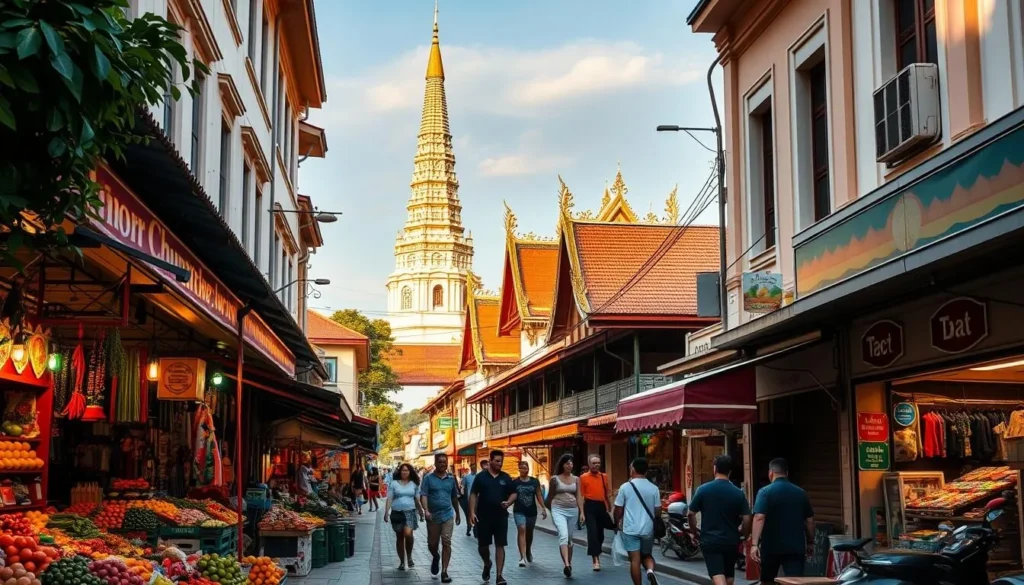
To make the most of yourtimein Songkhla, plan your visit around the dry season and stay flexible with your itinerary. As atourist, being mindful of local customs will enrich your experience. With these practical tips, you’re ready to explore Songkhla and enjoy all thatHat Yaiand its surroundings have to offer.
Conclusion: Why Songkhla Deserves Your Visit
If you’re seeking an authentic Thai experience, look no further than Songkhla, a city that embodies the essence of Thailand’s heritage. With its unique blend of natural beauty, rich history, and cultural diversity, Songkhla is a destination that will captivate your senses.
Songkhla offers a refreshingly authentic Thai experience that stands in stark contrast to more commercialized tourist destinations elsewhere in the country. From the historic charm of Old Town to the natural splendor of Samila Beach, Songkhla provides a perfect balance of things to do without overwhelming crowds.
As a place that remains somewhat under the radar for international tourists, Songkhla gives you the opportunity to visit Thailand at a more relaxed pace and often at lower prices. The warmth and hospitality of locals create a welcoming atmosphere, making Songkhla a place that rewards exploration. With a lot of things to do, Songkhla is sure to leave a lasting impression, making it a destination worth considering for your next trip.
The above is subject to change.
Check back often to TRAVEL.COM for the latest travel tips and deals.

